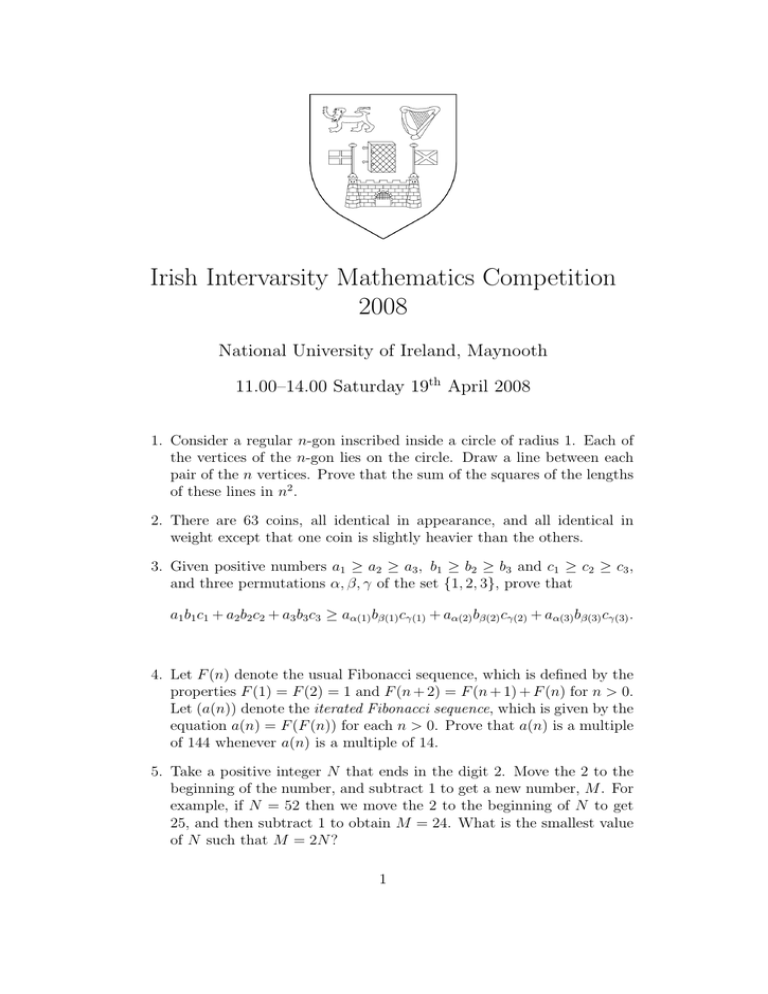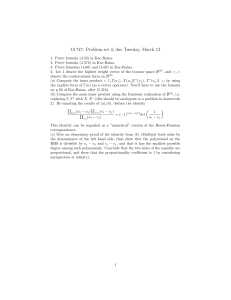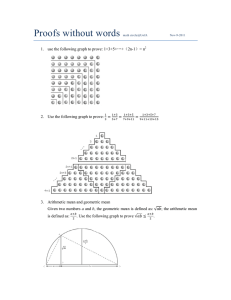Irish Intervarsity Mathematics Competition 2008 National University of Ireland, Maynooth 11.00–14.00 Saturday 19
advertisement

Irish Intervarsity Mathematics Competition
2008
National University of Ireland, Maynooth
11.00–14.00 Saturday 19th April 2008
1. Consider a regular n-gon inscribed inside a circle of radius 1. Each of
the vertices of the n-gon lies on the circle. Draw a line between each
pair of the n vertices. Prove that the sum of the squares of the lengths
of these lines in n2 .
2. There are 63 coins, all identical in appearance, and all identical in
weight except that one coin is slightly heavier than the others.
3. Given positive numbers a1 ≥ a2 ≥ a3 , b1 ≥ b2 ≥ b3 and c1 ≥ c2 ≥ c3 ,
and three permutations α, β, γ of the set {1, 2, 3}, prove that
a1 b1 c1 + a2 b2 c2 + a3 b3 c3 ≥ aα(1) bβ(1) cγ(1) + aα(2) bβ(2) cγ(2) + aα(3) bβ(3) cγ(3) .
4. Let F (n) denote the usual Fibonacci sequence, which is defined by the
properties F (1) = F (2) = 1 and F (n + 2) = F (n + 1) + F (n) for n > 0.
Let (a(n)) denote the iterated Fibonacci sequence, which is given by the
equation a(n) = F (F (n)) for each n > 0. Prove that a(n) is a multiple
of 144 whenever a(n) is a multiple of 14.
5. Take a positive integer N that ends in the digit 2. Move the 2 to the
beginning of the number, and subtract 1 to get a new number, M . For
example, if N = 52 then we move the 2 to the beginning of N to get
25, and then subtract 1 to obtain M = 24. What is the smallest value
of N such that M = 2N ?
1
6. For n = 1, 2, . . . let
an = n(n + 1),
bn = n + 1.
What is the value of the convergent sequence
a1
a1
a1
,
a2 ,
a2 , . . .?
b1 b1 + b 2 b1 + b 2 +
a3
b3
7. Let a triangle ABC have sides of length |AB| = 5, |BC| = 6, |CA| = 7,
and let the lengths of the perpendiculars from a point P inside the
triangle to the sides AB, BC and CA be x, y and z, respectively.
Find the minimum value of the sum x2 + y 2 + z 2 .
8. Let (an ) be a sequence of non-negative integers such that
an+1
an+2 =
,
an
where
( m!
if m ≥ k
m
= k!(m−k)!
k
0 otherwise
9. Show that there does not exist a differentiable function f : R → R
which satisfies the following equation for all real values x:
f 0 (x) ≥ 1 + |f (x)|2 .
10. In a room there are 2008 bulbs and 2008 buttons, and both are numbered from 1 to 2008. For each integer 1 ≤ i ≤ 2008, pressing Button
i changes the on or off status of Bulb i and one other bulb (the same
bulb each time). Assuming that all bulbs are initially off, prove that
by pressing the appropriate combination of buttons we can turn on at
least 1340 of them simultaneously on. Prove also that if the effects
of the buttons are chosen appropriately, 1340 is the largest number of
bulbs that can be simultaneously on.







